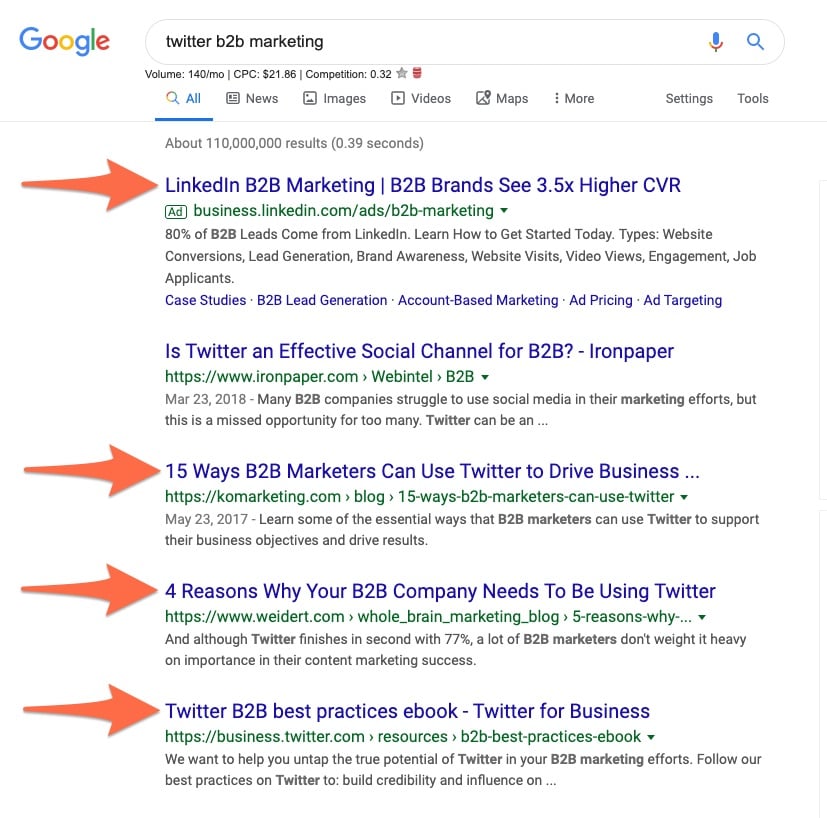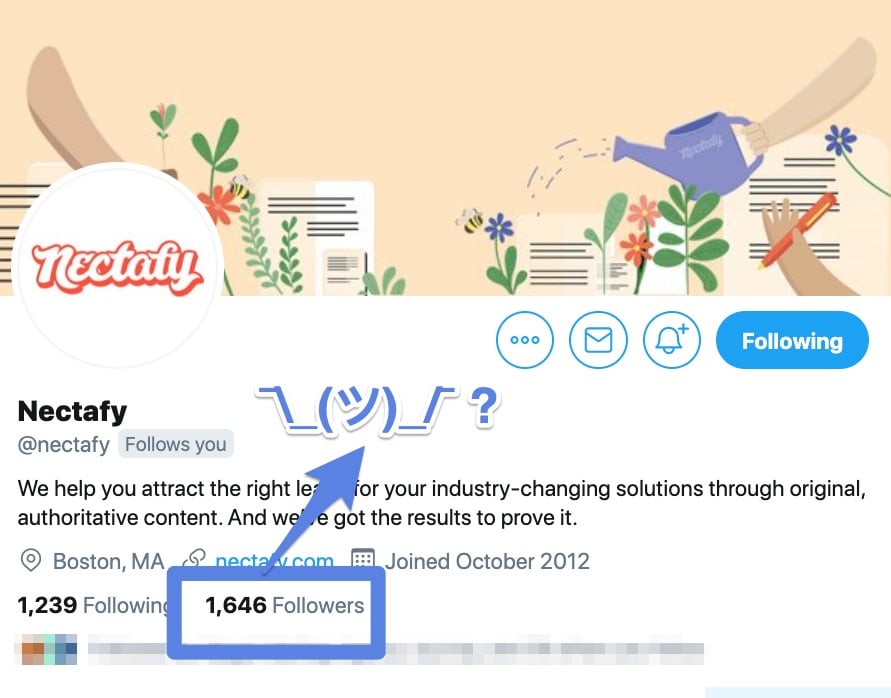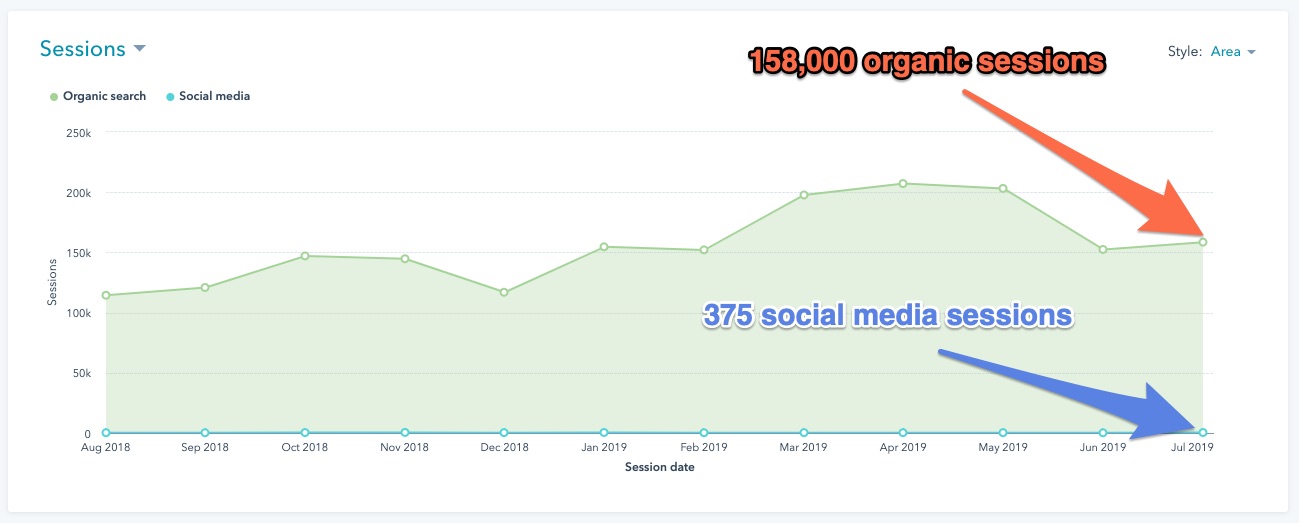4 Reasons B2B Twitter Marketing Is A Waste Of Time



If you do a Google search for B2B social media statistics or Twitter B2B marketing statistics, you’ll see pages of results about how social media is the key to reaching customers and growing your B2B business—most of them with impressive-looking statistics.

Don’t believe the hype.
Those search results? They’re almost exclusively articles posted by marketing companies who just happen to specialize in social media. Dig a little deeper and you’ll find precious little data about leads or business generated for B2B companies on social media. Instead, statistics such as “72% of adults are on Facebook” are used as stand-ins to demonstrate why your B2B business must use social media marketing, because that’s where everyone is.
While the statistics offered are real, for B2B companies they’re essentially meaningless. If you stop for a moment to think about how you use social media yourself, you’ll quickly understand why: Social media—with the possible exception of LinkedIn—is not where people go to search for business solutions. While 72% of adults may be on Facebook, they aren’t there to learn about what your business has to offer their business.
The most critical thing in any type of marketing is knowing who your customer is and where they are most likely to interact with you. The promise around social media has been that it makes your business human, allowing it to interact with people and sell things along the way. That promise falls short for B2B, because your product or service benefits businesses, not individual consumers.
To one degree or another, B2B businesses face this same issue with all social media platforms—but Twitter is probably the biggest waste of effort.
Why Twitter Is Probably A Waste Of Time For Your B2B Company
1 A tweet has reach only if you have followers who see it and share it.
If you’re on Twitter, you’re familiar with what gains traction on the platform and what doesn’t—and how much Twitter content ends up going out into the ether, never to be seen by anyone.
Few B2B companies can expect to attract more than a handful of followers, and unless your Twitter account is very active, most of the followers you do attract will never see your tweets, thanks to the Twitter timeline algorithm. Unless your followers are on the platform most of the time, or they follow very few accounts, your tweet will be buried deep in their timeline by the time they log in, and they will never see it.

For those few who do see your tweet, fewer still will retweet it, for a very simple reason:
2 Your B2B marketing message is of little or no interest to most people your followers interact with on Twitter.
On social media, people usually share things that are funny or outrageous; they rarely share advertising. Extreme and outlandish tweets are most often shared. To get widely shared on Twitter, you would probably end up representing your business in a less-than-businesslike way—not a good look when other businesses are your customers.
While sponsored tweets may allow wider reach without the risk of damaging your brand, if your audience isn’t on Twitter to interact with you, why bother?
When you evaluate where your customers are and how people use Twitter, you’ll realize:
3 People aren’t on Twitter for business interaction (unless you’re another marketer). The most active businesses on Twitter are there for marketing.
While there might be a reason for a B2B company to be on Twitter if the goal is to show a human side, with team members tweeting about company culture or other topics, it’s not a viable marketing strategy.
And as tantalizing as a free marketing platform may be, there are still costs involved:
4 Marketing on Twitter is a time-consumer.
When you consider B2B marketing on Twitter, ask yourself: “If our customers are here, what kind of effort do we have to put into this channel to get some kind of measurable result?”
What’s true for most businesses—unless you’re a giant brand—is that you won’t have enough activity to even measure results on Twitter. Your marketing team could devote 20 hours a week to Twitter, but wouldn’t get enough results to make a measurable decision about whether it’s effective or not.
If you have a small marketing team, devoting even five to 10 hours of their time to Twitter per week adds up to a significant expense for little to no return.
We’ve seen B2B businesses measure their social media footprint and learn it’s only in the hundreds. Meanwhile, they’re getting organic visits to their site in the hundreds of thousands. The Twitter activity is just a blip in comparison.

Looking for a more effective way to generate leads for your B2B business? Download our free book, How To Build Your Own Lead Machine.
Focus On More Effective Channels For Generating Business
Part of the appeal of social media is its immediacy. It promises a quick fix—but long-term solutions are generally better for business. For B2B marketing, growth content makes more sense, because you’re reaching potential customers when they are actively looking for solutions. This is much easier—and more effective—than trying to break through the noise on Twitter or other social platforms. And—unlike social media posts which quickly get buried in followers’ timelines—good quality content can continue to attract potential customers to your website and generate leads for months or even years.
The primary thing to keep in mind in B2B marketing is that not everyone can be your customer. Instead of spending a lot of time and effort on social media, broadcasting your message to people who are mostly not your customers, growth content directly engages the people in your target audience at the critical point when they are most likely to do business.
No business has unlimited resources; it makes sense to focus your marketing efforts where they will generate the highest return. So stop worrying that your B2B business is missing out on the social media party, and concentrate on real solutions to deliver the results your business needs.

